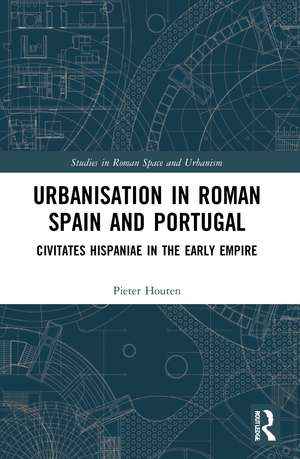Urbanisation in Roman Spain and Portugal: Civitates Hispaniae in the Early Empire: Studies in Roman Space and Urbanism
Autor Pieter Houtenen Limba Engleză Paperback – 29 ian 2024
While some chapters focus on settlements that were cities or towns from a juridical point of view, the implications of using a purely functional definition of towns are also explored. Key themes include continuities and discontinuities between pre-Roman and Roman settlement patterns, the geographical distribution of cities belonging to various size brackets, economic relationships between self-governing cities and their territories and the role of cities as nodes in road systems and maritime networks. In addition, it is argued that a considerable number of self-governing communities in Roman Spain and Portugal were poly-centric rather than based on a single urban centre.
The volume will be of interest to anyone working on Roman urbanism as well as those interested in the Iberian Peninsula in the Roman period.
| Toate formatele și edițiile | Preț | Express |
|---|---|---|
| Paperback (1) | 313.68 lei 6-8 săpt. | |
| Taylor & Francis – 29 ian 2024 | 313.68 lei 6-8 săpt. | |
| Hardback (1) | 771.17 lei 6-8 săpt. | |
| Taylor & Francis – 4 mar 2021 | 771.17 lei 6-8 săpt. |
Preț: 313.68 lei
Nou
Puncte Express: 471
Preț estimativ în valută:
60.03€ • 65.18$ • 50.42£
60.03€ • 65.18$ • 50.42£
Carte tipărită la comandă
Livrare economică 23 aprilie-07 mai
Preluare comenzi: 021 569.72.76
Specificații
ISBN-13: 9780367708672
ISBN-10: 0367708671
Pagini: 480
Ilustrații: 172
Dimensiuni: 156 x 234 x 30 mm
Greutate: 0.67 kg
Ediția:1
Editura: Taylor & Francis
Colecția Routledge
Seria Studies in Roman Space and Urbanism
Locul publicării:Oxford, United Kingdom
ISBN-10: 0367708671
Pagini: 480
Ilustrații: 172
Dimensiuni: 156 x 234 x 30 mm
Greutate: 0.67 kg
Ediția:1
Editura: Taylor & Francis
Colecția Routledge
Seria Studies in Roman Space and Urbanism
Locul publicării:Oxford, United Kingdom
Public țintă
Postgraduate and Undergraduate AdvancedCuprins
List of tables; Acknowledgements; List of abbreviations; 1. The ancient city on the Iberian Peninsula; 2. The origins of urbanisation on the Iberian Peninsula; 3. Self-governing civitates in the Early Empire; 4. Secondary agglomerations and urban functions; 5. Monuments for urban lifestyle; 6. Quantifying the urban network; Appendix I: self-governing cities alphabetically; Appendix II: self-governing communities with evidence table; Bibliography; Index
Notă biografică
Pieter Houten is a research fellow within the ERC-project 'LatinNow: Latinization of the North-Western Provinces' at the University of Nottingham, UK, and the Centre for the Study of Ancient Documents at the University of Oxford, UK. He wrote his PhD thesis Civitates Hispaniae within the ERC-funded project ‘An Empire of 2,000 Cities’ at Leiden University, Netherlands. His research focuses on urbanisation and Latinisation on the Iberian Peninsula in the Roman period.
Recenzii
"[A] new analytical and well-documented work, with new interpretative and methodological contributions, which could enter fully into the scientific discussion on the phenomenon of urbanisation in Hispania... Houten's work... becomes part of the group of reference studies on Hispania that must be known and handled today." - sehepunkte
"Sin duda, la imagen global que presenta sobre el urbanismo hispano alcanza a convertirse hoy en un estudio de referencia, aunque siguen quedando cuestiones pendientes que solo clarificará el desarrollo de la arqueología." - Zephyrus
[Without a doubt, the overall picture it presents of Hispanic urbanism has become a reference study today, although there are still outstanding questions that will only be clarified by the development of archaeology.]
"Urbanisation in Roman Spain and Portugal está llamada a ser una obra de referencia sobre el urbanismo en la Península Ibérica en los primeros años del Imperio, ya que en sus menos de quinientas páginas logra condensar la imagen urbana del conjunto territorial antes y después de la llegada de Roma, teniendo en cuenta su diversidad cultural, lo que le permite interpretar las múltiples soluciones urbanísticas que se desarrollaron en Hispania." - Gerión
[Urbanisation in Roman Spain and Portugal is destined to become a reference work on urbanism on the Iberian Peninsula in the Early Empire, as in its less than five hundred pages it manages to condense the urban image of the whole territory before and after the arrival of Rome, taking into account its cultural diversity, which allows it to interpret the multiple urban planning solutions that developed in Hispania.]
"Sin duda, la imagen global que presenta sobre el urbanismo hispano alcanza a convertirse hoy en un estudio de referencia, aunque siguen quedando cuestiones pendientes que solo clarificará el desarrollo de la arqueología." - Zephyrus
[Without a doubt, the overall picture it presents of Hispanic urbanism has become a reference study today, although there are still outstanding questions that will only be clarified by the development of archaeology.]
"Urbanisation in Roman Spain and Portugal está llamada a ser una obra de referencia sobre el urbanismo en la Península Ibérica en los primeros años del Imperio, ya que en sus menos de quinientas páginas logra condensar la imagen urbana del conjunto territorial antes y después de la llegada de Roma, teniendo en cuenta su diversidad cultural, lo que le permite interpretar las múltiples soluciones urbanísticas que se desarrollaron en Hispania." - Gerión
[Urbanisation in Roman Spain and Portugal is destined to become a reference work on urbanism on the Iberian Peninsula in the Early Empire, as in its less than five hundred pages it manages to condense the urban image of the whole territory before and after the arrival of Rome, taking into account its cultural diversity, which allows it to interpret the multiple urban planning solutions that developed in Hispania.]
Descriere
The principal aims of the book Urbanisation in Roman Spain and Portugal: Civitates Hispaniae in the Early Empire are to provide a comprehensive reconstruction of the urban systems of the Iberian Peninsula during the Early Empire and to explain why these systems looked the way they did.










